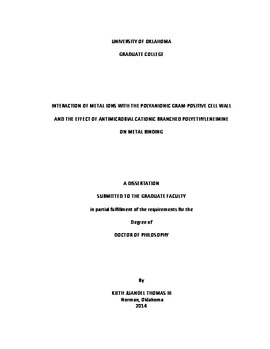| dc.description.abstract | Metal binding is a known characteristic of the bacterial cell wall. Yet, the binding mechanisms and affinity constants are not fully understood. The cell wall of Gram-positive bacteria is characterized by a thick layer of peptidoglycan and anionic teichoic acids anchored in the cytoplasmic membrane (lipoteichoic acid) or covalently bound to the cell wall (wall teichoic acid). The polyphosphate groups contribute to metal binding, while previous studies have suggested that the carboxyl units of peptidoglycan are primarily responsible for the metal binding behavior of the cell wall. As a result, there are many contradictory theories that describe binding affinity and the binding mode of divalent metal cations.
Equilibrium association constants and total metal binding capacities for the interaction of calcium and magnesium ions with the bacterial cell wall will be reported in this dissertation. Cell wall fragments of a chloramphenicol resistant strain of B. subtilis 1A578 were able to bind approximately twice as much Ca2+ and Mg2+ than a mutant deficient of wall teichoic acid. However, association constants were similar for each sample with both metal ions. Curvature of Scatchard plots from the binding data and the resulting two regions of binding affinity suggest the presence of negative cooperative binding, meaning that the binding affinity decreases as more ions become bound to the sample. This contradicts the current paradigm of there being a single metal affinity value that is constant over a range of concentrations.
One of the many functions of teichoic acid involves obtaining and sequestering metal ions required for biochemical processes. These ions must traverse the thick layer of peptidoglycan and reach the cytoplasmic membrane where transmembrane proteins control transport into the cell. Delivery of metals is aided by anionic binding sites within the peptidoglycan and the along the phosphodiester polymer of teichoic acid. The interaction with metals is a delicate balance between the need for Coulombic attraction and ion diffusion to the membrane. Through the use of Flame AA and equilibrium dialysis, we are able to measure the metal binding capacity and metal binding affinity of wall teichoic acid and Mg2+. The data show that Mg2+ binds to WTA with a 1:2 Mg2+ to phosphate ratio with a binding capacity of 1.27 µmol/mg. The affinity of Mg2+ to WTA was also found to be 41 x 103 M-1 at low salt concentrations and 1.3 x 103 M-1 at higher Mg2+ concentrations due to weakening electrostatic effects. These values are much lower than the values describing Mg2+ interactions with either peptidoglycan or peptidoglycan plus covalently bound WTA. Thus, we propose a model of facilitated ion transport to the inner cell wall surface by teichoic acids that permits increased structural integrity from metals binding to peptidoglycan.
Experiments to disrupt the metal binding behavior of the cell wall involved low molecular weight branched polyethyleneimine (BPEI). BPEI is reported to have an antimicrobial effect on bacteria. The killing mechanism of BPEI centers on its polycationic properties. Against Gram-negative bacteria, penetration into the cytoplasmic membrane leads to cell depolarization. The mechanism of action against Gram-positive bacteria is less understood but work suggests that membrane depolarization also occurs. In this dissertation, a different explanation of cell death is reported. BPEI hinders the binding of essential metals to the cell wall by occupying anionic sites of peptidoglycan and teichoic acid. Through equilibrium dialysis experiments and spectrophotometric quantification methods for BPEI, our data indicate that BPEI becomes electrostatically bound to the cell. This interaction leads to a decrease in the cells wall’s affinity and capacity towards Mg2+ cations. Additionally, BPEI also causes the release of Mg2+ ions from intact whole cells of Bacillus subtilis. The decrease in available metal binding sites also explains the ability of BPEI to a cause bacteriostatic effect on bacterial growth.
The in vitro synergistic effects of combinations of BPEI and antibiotics were examined between two resistant strains of B. subtilis. The emergence of multi-antibiotic resistant Gram-positive bacteria is becoming an increasing concern. Recent reports have shown PEI to have a synergetic effect with antibiotics on a clinical resistant strain of Gram-negative bacteria. Here we report that similar effects are observed with B. subtilis, a Gram-positive bacterium. Furthermore, morphological changes in response to BPEI exposure are reported through the use of both phase contrast microscopy and scanning electron microscopy. Thicker and random coiled bacterial cells that have a perturbed ability to form septa and separate are observed with these microscopy images. Lag phase was increased by up to two days when B. subtilis was exposed to sub-lethal concentrations. These cells eventually reached exponential phase where they began to divide and exhibit traditional morphologies and cell widths. | en_US |
